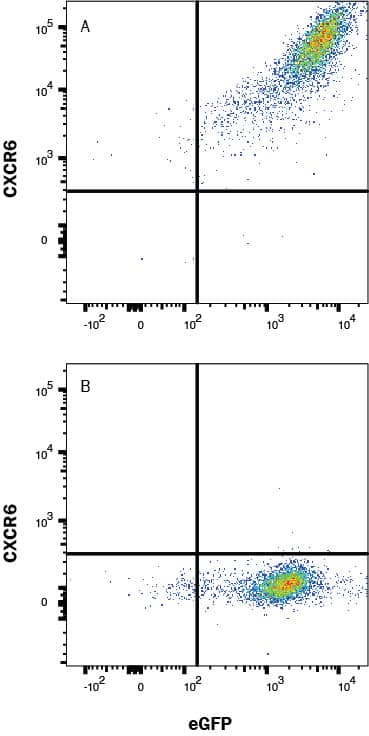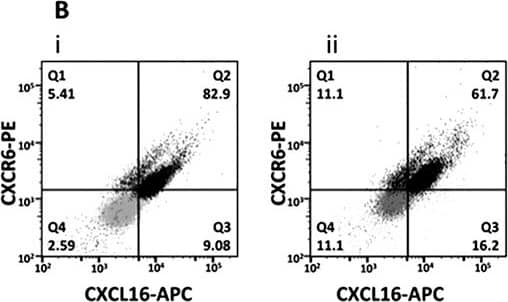Human CXCR6 PE-conjugated Antibody
Human CXCR6 PE-conjugated Antibody Summary
Met1-Leu342
Accession # O00574
Applications
Please Note: Optimal dilutions should be determined by each laboratory for each application. General Protocols are available in the Technical Information section on our website.
Scientific Data
 View Larger
View Larger
Detection of CXCR6 in Human PBMCs by Flow Cytometry. Human peripheral blood mononuclear cells (PBMCs) treated with 150 ng/mL Recombinant Human IL-2 (Catalog # 202-IL) for 6 days were stained with Mouse Anti-Human CXCR6 PE-conjugated Monoclonal Antibody (Catalog # FAB699P) and Mouse Anti-Human CD3e APC-conjugated Monoclonal Antibody (FAB100A). Quadrant markers were set based on control antibody staining (IC0041P). View our protocol for Staining Membrane-associated Proteins.
 View Larger
View Larger
Detection of CXCR6 in HEK293 cells by Flow Cytometry. HEK293 cells transfected with Human CXCR6 and eGFP (A) vs irrelevant and eGFP (B) were stained with Mouse Anti-Human CXCR6 PE‑conjugated Monoclonal Antibody (Catalog # FAB699P) at 37°C. View our protocol for Staining Membrane-associated Proteins.
 View Larger
View Larger
Detection of Human CXCR6 by Flow Cytometry CXCR6 and CXCL16 expression in LuCa cell lines(A) mRNA levels by semiquantitative RT-PCR. The copies of CXCR6 and CXCL16 transcripts are expressed relative to copies of 18S rRNA. Values are mean ± SEM from 3 independent experiments. *p ≤ 0.05, ***p ≤ 0.001 as compared to SCC (NCI-H520). (B) Flow cytometry analysis of CXCR6 and trans-membrane CXCL16 in (i) - SCC (NCI-H520) cells and (ii) - AC (NCI-H2126) cells. Grey dots represent isotype controls for PE and APC antibody and black dots represent CXCR6-PE and CXCL16-APC in SCC (NCI-H520) and AC (NCI-H2126). CXCR6 and CXCL16 both are expressed on ~82.9% (Q2) SCC cells; 5.41% (Q1) express only CXCR6 and only CXCL16 is expressed by 9.08% (Q3) of SCC cells. In AC cells, 61.7% of the population express both receptor and ligand (Q2) whereas, 11.1 (Q1) and 16.2% (Q3) cells express only CXCR6 and CXCL16, respectively. c) Levels of soluble CXCL16 in LuCa supernatant. Values are mean ± SEM from 3 independent experiments. ***p ≤ 0.0001 compared to NCI-H520. Image collected and cropped by CiteAb from the following publication (https://www.oncotarget.com/lookup/doi/10.18632/oncotarget.3194), licensed under a CC-BY license. Not internally tested by R&D Systems.
Reconstitution Calculator
Preparation and Storage
- 12 months from date of receipt, 2 to 8 °C as supplied.
Background: CXCR6
CXCR6, also known as Bonzo and STRL33, is a G protein coupled chemokine receptor expressed on activated T cells and tumor-infiltrating lymphocytes. It binds soluble CXCL16 and membrane-anchored CXCL16 expressed on dendritic cells and macrophages.
Product Datasheets
Citations for Human CXCR6 PE-conjugated Antibody
R&D Systems personnel manually curate a database that contains references using R&D Systems products. The data collected includes not only links to publications in PubMed, but also provides information about sample types, species, and experimental conditions.
17
Citations: Showing 1 - 10
Filter your results:
Filter by:
-
Human liver infiltrating gamma δ T cells are composed of clonally expanded circulating and tissue-resident populations
Authors: Stuart Hunter, Carrie R. Willcox, Martin S. Davey, Sofya A. Kasatskaya, Hannah C. Jeffery, Dmitriy M. Chudakov et al.
Journal of Hepatology
-
The DRF motif of CXCR6 as chemokine receptor adaptation to adhesion
Authors: A Koenen, A Babendreye, J Schumacher, T Pasqualon, N Schwarz, A Seifert, X Deupi, A Ludwig, D Dreymuelle
PLoS ONE, 2017-03-07;12(3):e0173486.
Species: Human
Sample Types: Whole Cells
Applications: Flow Cytometry -
Detection of Primary T Cell Responses to Drugs and Chemicals in HLA-Typed Volunteers: Implications for the Prediction of Drug Immunogenicity
Authors: Lee Faulkner
Toxicol. Sci, 2016-09-16;154(2):416-429.
Species: Human
Sample Types: Whole Cells
Applications: Flow Cytometry -
Human liver-resident CD56(bright)/CD16(neg) NK cells are retained within hepatic sinusoids via the engagement of CCR5 and CXCR6 pathways.
Authors: Hudspeth K, Donadon M, Cimino M, Pontarini E, Tentorio P, Preti M, Hong M, Bertoletti A, Bicciato S, Invernizzi P, Lugli E, Torzilli G, Gershwin M, Mavilio D
J Autoimmun, 2015-08-30;66(0):40-50.
Species: Human
Sample Types: Whole Cells
Applications: Flow Cytometry -
Mesenchymal stromal cell secretome up-regulates 47 kDa CXCR4 expression, and induce invasiveness in neuroblastoma cell lines.
Authors: Shankar V, Hori H, Kihira K, Lei Q, Toyoda H, Iwamoto S, Komada Y
PLoS ONE, 2015-03-16;10(3):e0120069.
Species: Human
Sample Types: Whole Cells
Applications: Flow Cytometry -
Invariant natural killer T cells act as an extravascular cytotoxic barrier for joint-invading Lyme Borrelia.
Authors: Lee, Woo-Yong, Sanz, Maria-Je, Wong, Connie H, Hardy, Pierre-O, Salman-Dilgimen, Aydan, Moriarty, Tara J, Chaconas, George, Marques, Adriana, Krawetz, Roman, Mody, Christop, Kubes, Paul
Proc Natl Acad Sci U S A, 2014-09-09;111(38):13936-41.
Species: Human
Sample Types: Whole Tissue
Applications: IHC -
CXCL16 and CXCR6 are coexpressed in human lung cancer in vivo and mediate the invasion of lung cancer cell lines in vitro.
Authors: Hu, Weidong, Liu, Yue, Zhou, Wenhui, Si, Lianlian, Ren, Liang
PLoS ONE, 2014-06-04;9(6):e99056.
Species: Human
Sample Types: Whole Cells
Applications: Flow Cytometry -
Increased numbers of immature plasma cells in peripheral blood specifically overexpress chemokine receptor CXCR3 and CXCR4 in patients with ulcerative colitis.
Authors: Hosomi S, Oshitani N, Kamata N, Sogawa M, Okazaki H, Tanigawa T, Yamagami H, Watanabe K, Tominaga K, Watanabe T, Fujiwara Y, Maeda K, Hirakawa K, Arakawa T
Clin. Exp. Immunol., 2010-11-19;163(2):215-24.
Species: Human
Sample Types: Whole Cells
Applications: Flow Cytometry -
Human MAIT cells are xenobiotic-resistant, tissue-targeted, CD161hi IL-17-secreting T cells.
Authors: Dusseaux M, Martin E, Serriari N, Peguillet I, Premel V, Louis D, Milder M, Le Bourhis L, Soudais C, Treiner E, Lantz O
Blood, 2010-11-17;117(4):1250-9.
Species: Human
Sample Types: Whole Cells
Applications: Flow Cytometry -
Distinct roles for CCR4 and CXCR3 in the recruitment and positioning of regulatory T cells in the inflamed human liver.
Authors: Oo YH, Weston CJ, Lalor PF, Curbishley SM, Withers DR, Reynolds GM, Shetty S, Harki J, Shaw JC, Eksteen B, Hubscher SG, Walker LS, Adams DH
J. Immunol., 2010-02-17;184(6):2886-98.
Species: Human
Sample Types: Whole Cells
Applications: Flow Cytometry -
AIDS progression is associated with the emergence of IL-17-producing cells early after simian immunodeficiency virus infection.
Authors: Campillo-Gimenez L, Cumont MC, Fay M, Kared H, Monceaux V, Diop O, Muller-Trutwin M, Hurtrel B, Levy Y, Zaunders J, Dy M, Leite-de-Moraes MC, Elbim C, Estaquier J
J. Immunol., 2009-12-16;184(2):984-92.
Species: Primate - Macaca mulatta (Rhesus Macaque)
Sample Types: Whole Cells
Applications: Flow Cytometry -
Expression of the CXCR6 on polymorphonuclear neutrophils in pancreatic carcinoma and in acute, localized bacterial infections.
Authors: Gaida MM, Gunther F, Wagner C, Friess H, Giese NA, Schmidt J, Hansch GM, Wente MN
Clin. Exp. Immunol., 2008-09-05;154(2):216-23.
Species: Human
Sample Types: Whole Cells
Applications: Flow Cytometry -
CXCR6-CXCL16 interaction in the pathogenesis of Juvenile Idiopathic Arthritis.
Authors: Martini G, Cabrelle A, Calabrese F, Carraro S, Scquizzato E, Teramo A, Facco M, Zulian F, Agostini C
Clin. Immunol., 2008-08-28;129(2):268-76.
Species: Human
Sample Types: Whole Cells
Applications: Flow Cytometry, ICC -
Down-modulation of CXCR3 surface expression and function in CD8+ T cells from cutaneous T cell lymphoma patients.
Authors: Winter D, Moser J, Kriehuber E, Wiesner C, Knobler R, Trautinger F, Bombosi P, Stingl G, Petzelbauer P, Rot A, Maurer D
J. Immunol., 2007-09-15;179(6):4272-82.
Species: Human
Sample Types: Whole Cells
Applications: Flow Cytometry -
CC chemokine receptor 5 and CXC chemokine receptor 6 expression by lung CD8+ cells correlates with chronic obstructive pulmonary disease severity.
Authors: Freeman CM, Curtis JL, Chensue SW
Am. J. Pathol., 2007-07-19;171(3):767-76.
Species: Human
Sample Types: Whole Cells
Applications: Flow Cytometry -
Cross-Talk Between circRNAs and mRNAs Modulates MiRNA-mediated Circuits and Affects Melanoma Plasticity
Authors: Maria Rita Fumagalli, Maria Chiara Lionetti, Stefano Zapperi, Caterina A. M. La Porta
Cancer Microenvironment
-
CXCL16/CXCR6 Axis Drives Microglia/Macrophages Phenotype in Physiological Conditions and Plays a Crucial Role in Glioma
Authors: Lepore F, D'Alessandro G, Antonangeli F et al.
Front Immunol
FAQs
No product specific FAQs exist for this product, however you may
View all Antibody FAQsReviews for Human CXCR6 PE-conjugated Antibody
There are currently no reviews for this product. Be the first to review Human CXCR6 PE-conjugated Antibody and earn rewards!
Have you used Human CXCR6 PE-conjugated Antibody?
Submit a review and receive an Amazon gift card.
$25/€18/£15/$25CAN/¥75 Yuan/¥2500 Yen for a review with an image
$10/€7/£6/$10 CAD/¥70 Yuan/¥1110 Yen for a review without an image


